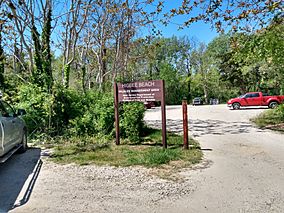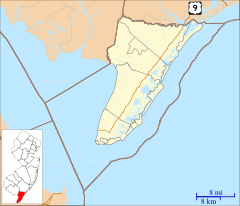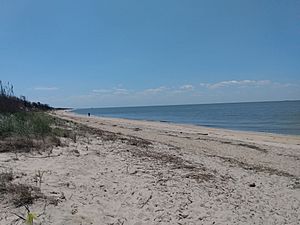Higbee Beach Wildlife Management Area facts for kids
Quick facts for kids Higbee Beach Wildlife Management Area |
|
|---|---|
 |
|
| Location | Lower Township, Cape May County, New Jersey |
| Nearest city | West Cape May |
| Area | 1,159 acres (469 ha) |
| Governing body | New Jersey Division of Fish and Wildlife |
The Higbee Beach Wildlife Management Area is a special place in New Jersey. It covers about 1,159 acres (469 hectares) of land. This area is near West Cape May in Lower Township, Cape May County, New Jersey. It's a protected spot where animals and plants can live safely.
Contents
Exploring Higbee Beach's Landscape
Higbee Beach has a beautiful shoreline that stretches for about 1.5 miles. This sandy stretch goes from New England Road all the way to Sunset Boulevard.
Special Spots to Discover
Within the Wildlife Management Area, you can find several interesting places:
- Signal Hill: A large dune that offers great views.
- Davey’s Lake: A long, narrow lake.
- Pond Creek: A small waterway.
- Sassafras Island: An area named after the sassafras trees.
- Hidden Valley: A former farm now part of the protected area.
- Magnesite Plant: An old industrial site.
Hidden Valley Farm and Davey's Lake
The Hidden Valley farm used to be a 92-acre property. It was bought by New Jersey in 1986. Now, it is part of Higbee Beach. Some parts of the old farm are even used for horseback riding!
Davey's Lake is a man-made lake. It is about 300 yards long, 90 yards wide, and 12 feet deep. The Cape May Sand Company dug this lake in 1910.
A Glimpse into Higbee Beach's Past
Higbee Beach has a long and interesting history. It has changed a lot over the years.
Early Days and the Higbee Family
Around 1807, a small inn was built near the Delaware Bay. Thomas and Rhoda Forrest ran it for many years. In 1823, a ship pilot named Joseph S. Higbee bought the land. By 1830, he owned a very large farm. He used this spot as a place where people traveling from Philadelphia could get off their boats.
After Joseph Higbee passed away in 1872, his brother Thomas Higbee took over. Thomas ran a small hotel there. He wanted the property to stay in his family forever. However, after he died, his niece Etta inherited it. She passed away just seven years later. The property was then sold outside of the family. Thomas Higbee's body was even moved from the property to a new burial spot at Cold Spring Presbyterian Church.
Railroads, Testing, and Prohibition
In the early 1900s, railroad tracks were built along the beach. These tracks helped with sand mining in the area. Eventually, the tracks were no longer used. They became buried by the ocean tides. But sometimes, the tides shift, and parts of the old tracks reappear! This happened in 2014 and several times since.
During World War I, a company bought land at Higbee Beach. They used it as a testing ground for artillery shells. This facility closed soon after the war ended. Later, during a time called Prohibition, people were not allowed to make or sell alcohol. Higbee Beach became a secret spot for people to bring in illegal alcohol. The large dune called Signal Hill was used as a lookout point for these activities. In 1940, the old hotel was torn down. A plant that made a material called magnesite was built in 1941. It operated until it was taken down in 1989.
Local Legends and Ghost Stories
Some people say that Higbee Beach is haunted! There are stories about a phantom black dog. Some believe it was cursed by Native Americans. Another legend tells of a strange man in a coat and hat. Many think this might be the ghost of Thomas Higbee himself!
Amazing Plants and Animals
Higbee Beach is a very important place for wildlife. It is especially famous for its birds.
Bird Migration and Breeding
Higbee Beach is a major stop for one of the world's largest bird migrations in North America. Many different types of birds fly through here. The Endangered and Nongame Species Program helps manage and protect birds like raptors (birds of prey) and songbirds.
During spring and summer, several bird species come to Higbee Beach to have their babies. These include the Blue Grosbeak, Indigo Bunting, Yellow-breasted Chat, and Prairie Warbler.
Other Wildlife and Unique Plants
Besides birds, you can also find many dragonflies and butterflies at Higbee Beach. The dunes along the beach are kept stable by a special forest. This forest has trees and plants like holly, red cedar, sassafras, and wild black cherry. You can also find common wax myrtle and beach plum here. A very rare type of orchid, called Spiranthes odorata, also grows at Higbee Beach.
Fun Activities at Higbee Beach
Higbee Beach is a great place to explore and enjoy nature.
Trails and Hunting
There are about 2 miles of trails at Higbee Beach. These trails are perfect for walking and exploring. In 1999, a special dune trail was added. Hunting is allowed here, but only during specific times of the year. It usually starts the Monday after the Six-day Firearm Deer Season.
Cape May Diamonds and Swimming
Higbee Beach is a popular spot to search for "Cape May diamonds". These are special quartz crystals that have been smoothed and polished by the ocean. They look like shiny gems!
Even though swimming is officially not allowed, many people still enjoy swimming in the bay here. The rules are not strictly enforced, so you will often see swimmers enjoying the water.



